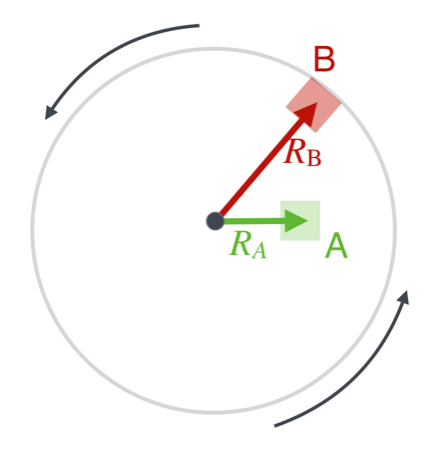The Big Mo, Force and Momentum
Example 8: merry-go-round.
The Question: The figure shows an upper view of a merry-go-round rotating counterclockwise with two children, Arnie (A) and Bertha (B) at two different distances from the center.

Suppose Arnie is just standing with no holding on of the railings. You’ve all done it: what keeps him riding? Hint: suppose the platform’s surface is covered with ice, would he be as secure if it was sticky wood? So of course, it’s the frictional grip — the force of friction between his shoes and the surface that supply the centripetal force pointing to the center.
(a) What is the force of friction required to hold Arnie on board? (b) Is the force of friction required less or more to hold Bertha?
Here are the particulars: m and m. The merry-go-round makes one complete revolution in 10 seconds and each child weighs 50 pounds, so 22.7 kg each.
The Answer:
(a) In order to know the force of friction required, we need to know the speed.
We need the speed and then we can get the centripetal force since we know the mass and the radius, :
The force is then
which is about 6 pounds of force directed to the center. Maybe sticky tennis shoes?
You’ve all done it and you know that it can be very hard to live on the edge. So to speak.
Some symbolic manipulation will address how much force relative to Arnie:
so the further out she squinches towards the edge ( getting larger), the higher is the sticky force of her shoes and the surface that she needs in order to not slide off — to stay on the merry-go-round. Bertha had better be wearing baseball cleats.